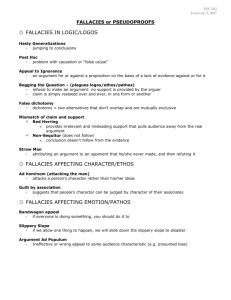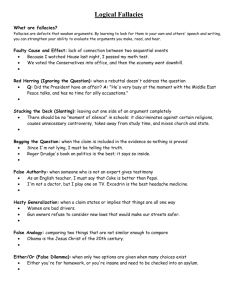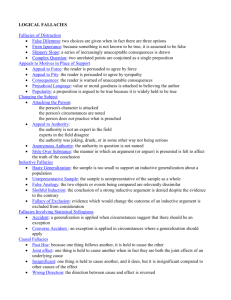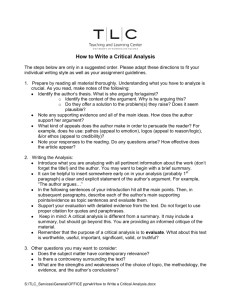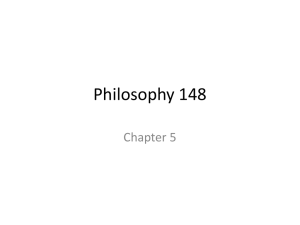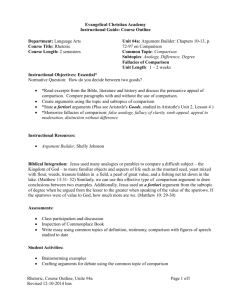A. What is a fallacy?
advertisement
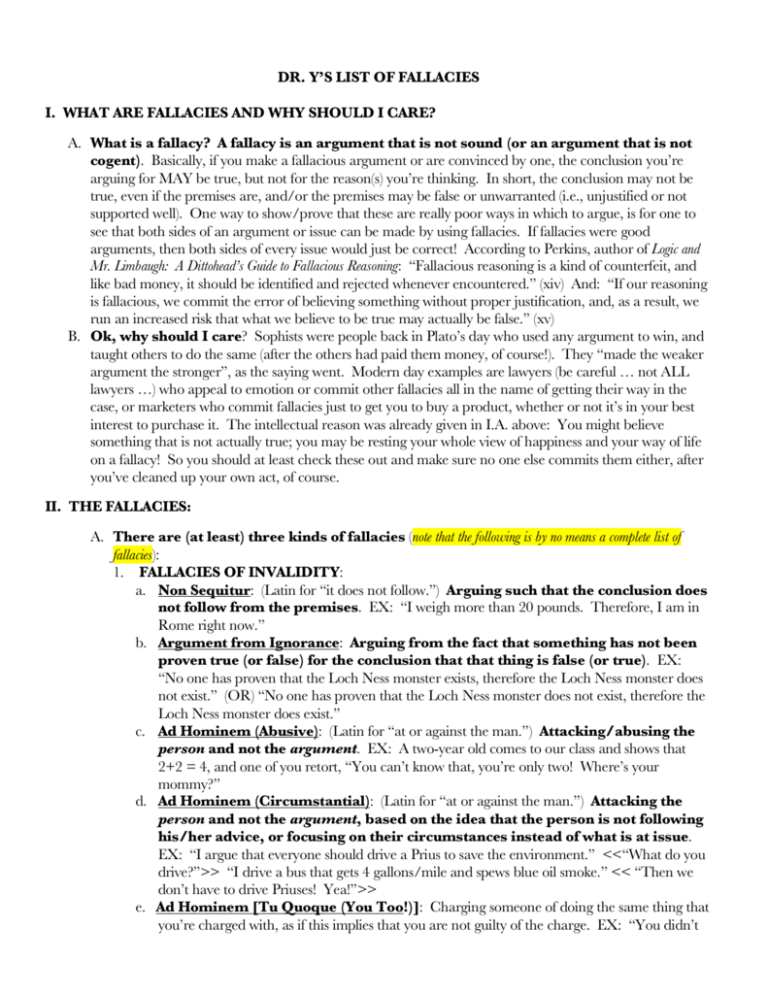
DR. Y’S LIST OF FALLACIES I. WHAT ARE FALLACIES AND WHY SHOULD I CARE? A. What is a fallacy? A fallacy is an argument that is not sound (or an argument that is not cogent). Basically, if you make a fallacious argument or are convinced by one, the conclusion you’re arguing for MAY be true, but not for the reason(s) you’re thinking. In short, the conclusion may not be true, even if the premises are, and/or the premises may be false or unwarranted (i.e., unjustified or not supported well). One way to show/prove that these are really poor ways in which to argue, is for one to see that both sides of an argument or issue can be made by using fallacies. If fallacies were good arguments, then both sides of every issue would just be correct! According to Perkins, author of Logic and Mr. Limbaugh: A Dittohead’s Guide to Fallacious Reasoning: “Fallacious reasoning is a kind of counterfeit, and like bad money, it should be identified and rejected whenever encountered.” (xiv) And: “If our reasoning is fallacious, we commit the error of believing something without proper justification, and, as a result, we run an increased risk that what we believe to be true may actually be false.” (xv) B. Ok, why should I care? Sophists were people back in Plato’s day who used any argument to win, and taught others to do the same (after the others had paid them money, of course!). They “made the weaker argument the stronger”, as the saying went. Modern day examples are lawyers (be careful … not ALL lawyers …) who appeal to emotion or commit other fallacies all in the name of getting their way in the case, or marketers who commit fallacies just to get you to buy a product, whether or not it’s in your best interest to purchase it. The intellectual reason was already given in I.A. above: You might believe something that is not actually true; you may be resting your whole view of happiness and your way of life on a fallacy! So you should at least check these out and make sure no one else commits them either, after you’ve cleaned up your own act, of course. II. THE FALLACIES: A. There are (at least) three kinds of fallacies (note that the following is by no means a complete list of fallacies): 1. FALLACIES OF INVALIDITY: a. Non Sequitur: (Latin for “it does not follow.”) Arguing such that the conclusion does not follow from the premises. EX: “I weigh more than 20 pounds. Therefore, I am in Rome right now.” b. Argument from Ignorance: Arguing from the fact that something has not been proven true (or false) for the conclusion that that thing is false (or true). EX: “No one has proven that the Loch Ness monster exists, therefore the Loch Ness monster does not exist.” (OR) “No one has proven that the Loch Ness monster does not exist, therefore the Loch Ness monster does exist.” c. Ad Hominem (Abusive): (Latin for “at or against the man.”) Attacking/abusing the person and not the argument. EX: A two-year old comes to our class and shows that 2+2 = 4, and one of you retort, “You can’t know that, you’re only two! Where’s your mommy?” d. Ad Hominem (Circumstantial): (Latin for “at or against the man.”) Attacking the person and not the argument, based on the idea that the person is not following his/her advice, or focusing on their circumstances instead of what is at issue. EX: “I argue that everyone should drive a Prius to save the environment.” <<“What do you drive?”>> “I drive a bus that gets 4 gallons/mile and spews blue oil smoke.” << “Then we don’t have to drive Priuses! Yea!”>> e. Ad Hominem [Tu Quoque (You Too!)]: Charging someone of doing the same thing that you’re charged with, as if this implies that you are not guilty of the charge. EX: “You didn’t do your homework; that’s wrong.” <<“You didn’t either!>> f. Appeal to Popularity/People/Vanity/Snobbery/Bandwagon Argument: Trying to prove one’s conclusion by arguing that many people agree with you or all the cool people believe or do X (appeal to popularity or bandwagon argument). EX1: “Democracy is the best form of government because most governments are shifting towards it; all these people can’t be wrong!” EX2: “The Few. The Proud. The Marines.” (Appeal to vanity – you too can be admired and respected if you join the Marines). EX3: “Only the best people drive car X; this car is not for everyone; see if you qualify for financing today.” (Appeal to snobbery – similar to vanity). g. Appeal to Pity or Emotion: Arguing for your conclusion by using emotion or trying to gain one’s pity instead of giving a good reason for one’s conclusion. EX: “My client (accused of murder) is very remorseful, and has a wonderful family who will really miss him if he is convicted; so you should find him innocent.” h. Appeal to Force (Argumentum Ad Baculum or Appeal to the “Stick”): Threatening physical, emotional or financial abuse in order to gain assent to one’s conclusion. EX: “If you don’t believe 2 + 2 is 5, I will beat you up!” i. Irrelevant Conclusion/Evading the Issue (a.k.a. Red Herring): Trying to evade the issue by raising another issue, instead of addressing the issue on the table. EX: Bush said in a debate in 2000 that Gore did not have good character, and Gore responded, “I thought we could avoid these attacks, so I will use my rebuttal time to talk about education.” j. Equivocation/Fallacy of Accent: Concluding an argument from a premise that uses different senses of a word or words. Impress your friends at cocktail parties with the following argument : 1. God is love. 2. Love is blind. 3. Ray Charles is blind. C: Ray Charles is God. k. Hasty Generalization: Possibility One: Generalizing from too little evidence to make one's argument. Possibility Two: Arguing from a premise that says Some/Few As are Bs, concludes that All or Most As are Bs. EX: “The first three MCC students I saw had nose rings. Therefore, every MCC student has a nose ring (or most MCC students have nose rings).” l. Questionable Cause/False Cause: Concluding from a premise that says A occurred before B, that A caused B. EX: “It’s been shown that 90% of people who are heroin addicts started smoking marijuana. So smoking marijuana causes heroin addiction.” m. Slippery Slope: Resting the conclusion of an argument on an alleged chain reaction when such a conclusion is not likely to actually occur. EX: “If the teacher allows Billy to turn his paper in 5 minutes late, soon we’ll all just be able to turn any assignments in at the end of the semester, because deadlines will mean nothing!” n. Amphiboly: Misinterpreting an ambiguous statement and then drawing a conclusion based on that. EX: Smith gave Brown and Jones $10; therefore he’s out $20. [In order to be an amphiboly, it must be true that Smith paid a total of $10 to both men together, and not $10 to each of them.] o. Composition: Unwarrantedly attributing characteristics of parts/members of a whole to the whole itself. EX: The atoms of this book are invisible; therefore the book is invisible. p. Division: Unwarrantedly attributing characteristics of the whole to its individual parts/members. EX: America is the wealthiest nation on earth, so Dave (an American) must be rich. 2. FALLACIES OF UNWARRANTED PREMISE: a. Straw Man: Concluding from a premise that says something untrue about an opponent or his/her position, that the opponent or position really is unworthy of our acceptance. EX: “The anti-war protestors think that we should change our government to a communist form of government, and never engage in war, even in selfdefense. Therefore, the anti-war position is irrational and should not be supported.” b. False Alternatives/Black or White Fallacy/False Dichotomy: Concluding from a premise that says certain alternatives are available (but omits at least one acceptable possibility) and a premise (often unexpressed) that all but one of these alternatives are unacceptable, that the remaining alternative must be accepted. EX: “America: Love it or leave it! Therefore, if you criticize any American policy as a U.S. citizen, you need to leave America.” c. Complex Question/Loaded Question: Assuming something is true in a question, such that the answerer cannot make a good/nice answer if they answer the question: EX: “When did you stop beating your wife or girlfriend?” d. Begging the Question/Circular Reasoning: Concluding from a premise that says something is so (which is what the argument is meant to prove), that that same thing is so (put in different language). Assuming what you want to prove. Circular Reasoning: When you argue for premise A by arguing that premise B is true, and that B is true because A is true. EX1 (Begging the Question): “Why do I need to do the dishes tonight? Just because.” That is, “You need to do the dishes tonight because you need to do the dishes tonight.” EX2 (Circular Reasoning): <<Why does God exist?>> “God exists because the Bible says God does.” <<“Why should I trust the Bible?”>> “Because it’s the word of God.” e. Inconsistency: Possibility One: Concluding anything from a premise that says, or implies that something both is and is not the case. Possibility Two: Concluding that something is not true from a premise that says that that thing is true. EX: “I believe that the fetus is a person with an absolute right to life. Therefore, I believe that abortion is morally wrong, except in cases of rape and incest.” 3. FALLACIES OF OMITTED EVIDENCE: a. Suppressed Evidence: Concluding (validly, without additional, omitted information) from a premise that makes conclusion likely (but omits important information which makes the conclusion unlikely). EX: “94% of males between 45 and 54 are, or have been, married. Joe is a 50-year-old male. Probably Joe is, or has been, married.” [But Joe is a Catholic priest who entered the priesthood at 14.] b. Appeal to Inappropriate Authority: Concluding from a premise saying that person P accepts a statement S (But P's knowledge or reliability is questionable), that S is true. EX: “I’m not a doctor, but I play one on TV; this cough medicine is awesome; therefore, you should buy this cough medicine.” c. Faulty Analogy/Weak Analogy: Reasoning by analogy that overlooks/ignores important dissimilarities between the things being compared. EX1: “A and B are similar in many ways; A is known to have characteristic C; So B has C also.” EX2: “Dad rode his bike to get to school and it worked for him. His son Jimmy can ride his bike to get to school. Therefore, Jimmy should ride his bicycle to school.” [To be a faulty analogy, it must be true that Jimmy now lives in a drug-infested neighborhood, or is in a wheelchair, or lives much further away from school, etc.] II. TIPS FOR DETECTING THE FALLACIES: A. Be charitable to the arguer (principle of charity). This is a general principle. B. Be faithful to the arguer's intended meaning (principle of fidelity), specifically with reference to wording. C. Determine what is the point at issue. That way, you’ll know what is trying to prove what, and can attempt to figure out what the conclusion is and what the premises are (or what the premise is). D. Look to see if the premises really support the conclusion (i.e., check for fallacies of invalidity). E. Look to see if the premises are true or warranted (i.e., check for fallacies of unwarranted premise). F. Look to see if the premises omit any facts that, if included, would weaken the argument (i.e., check for fallacies of omitted evidence).
